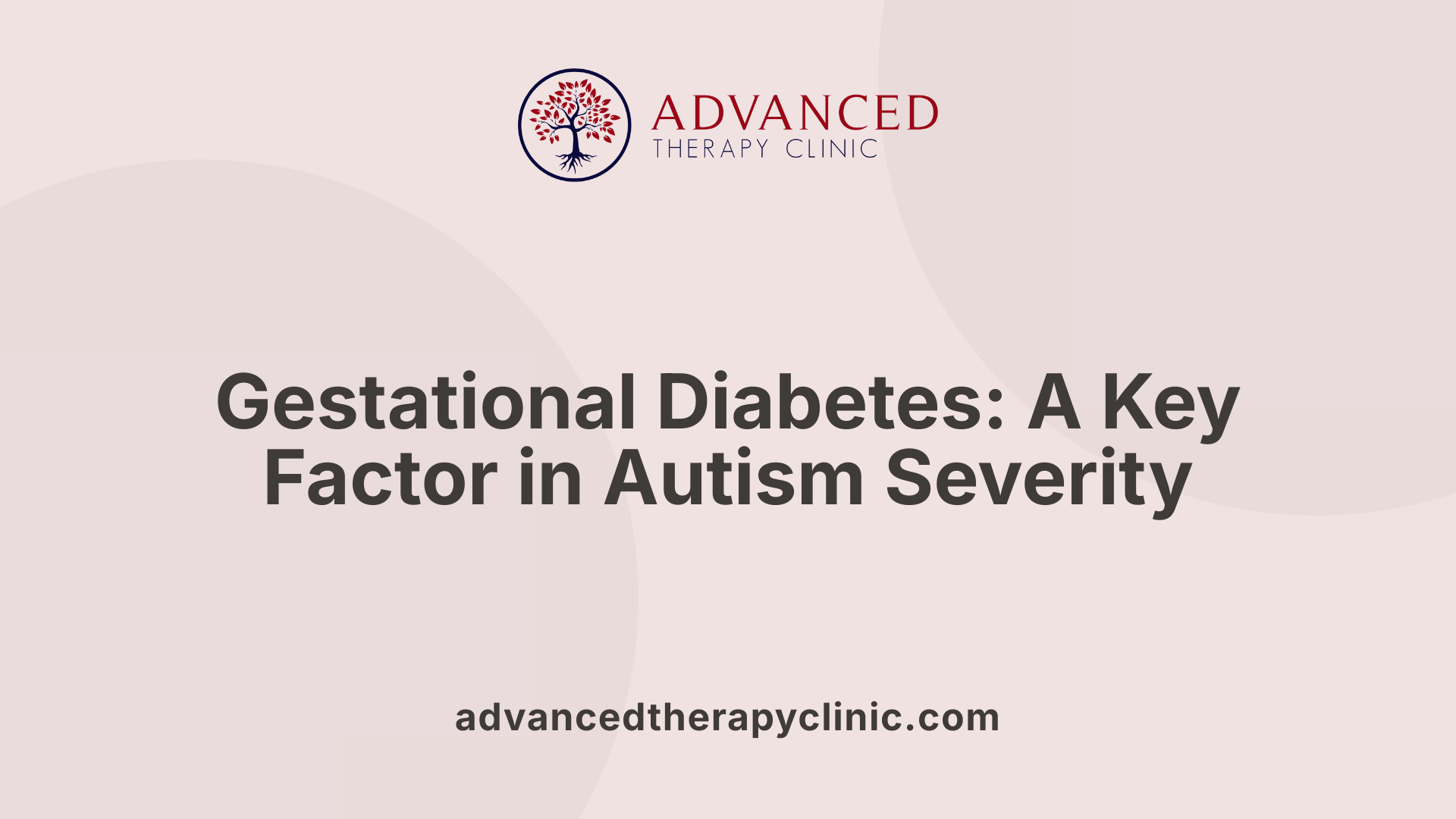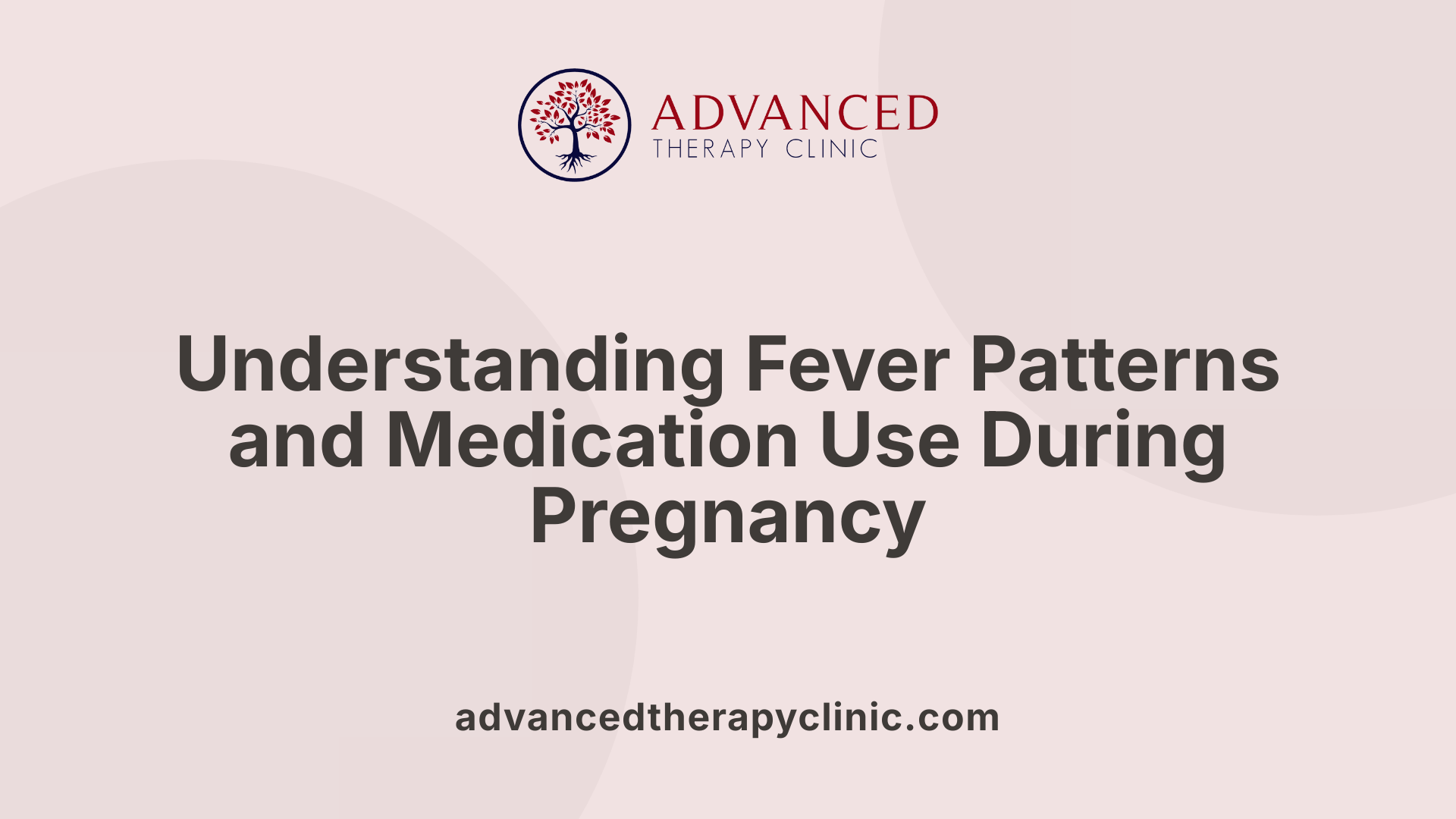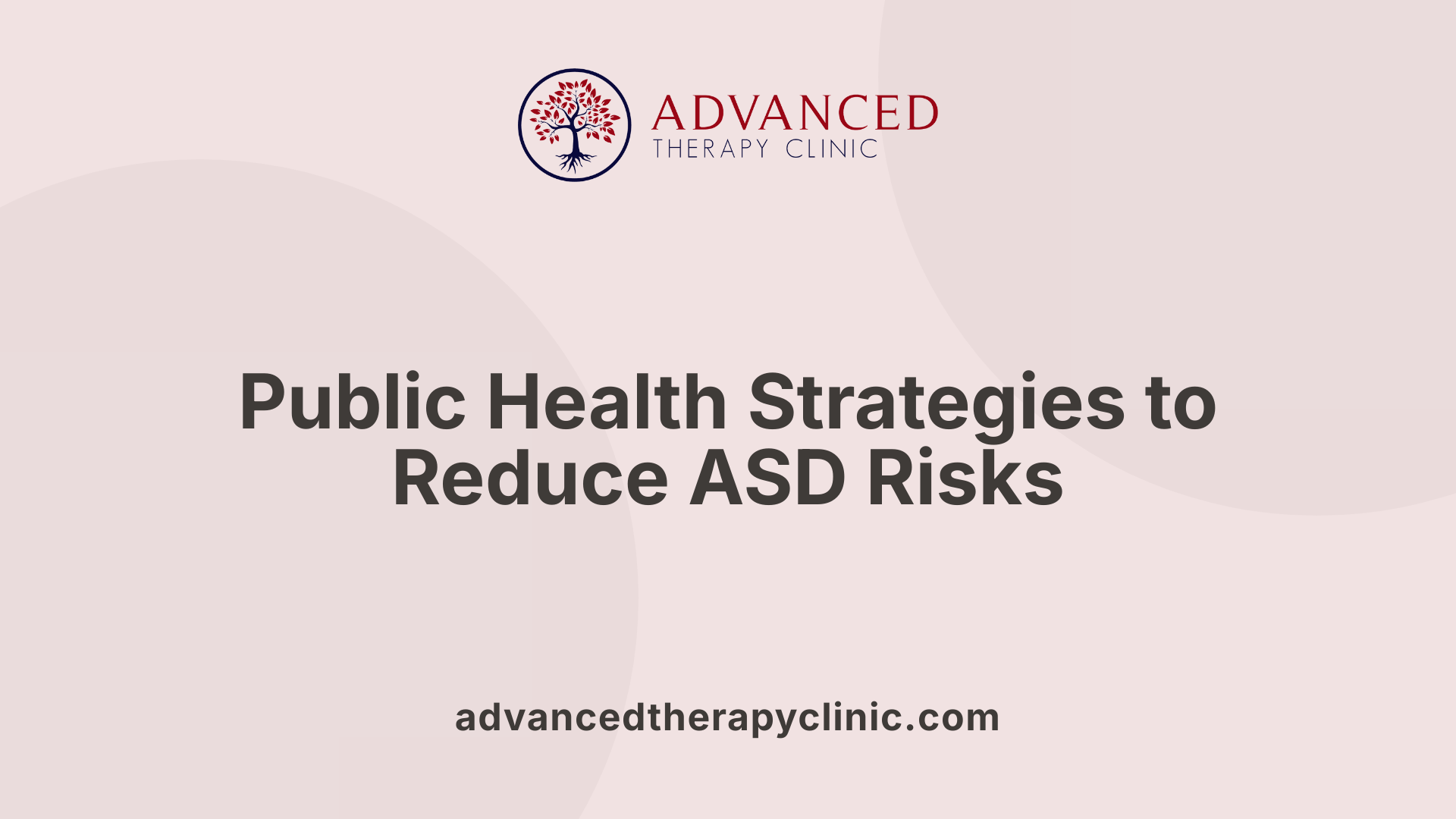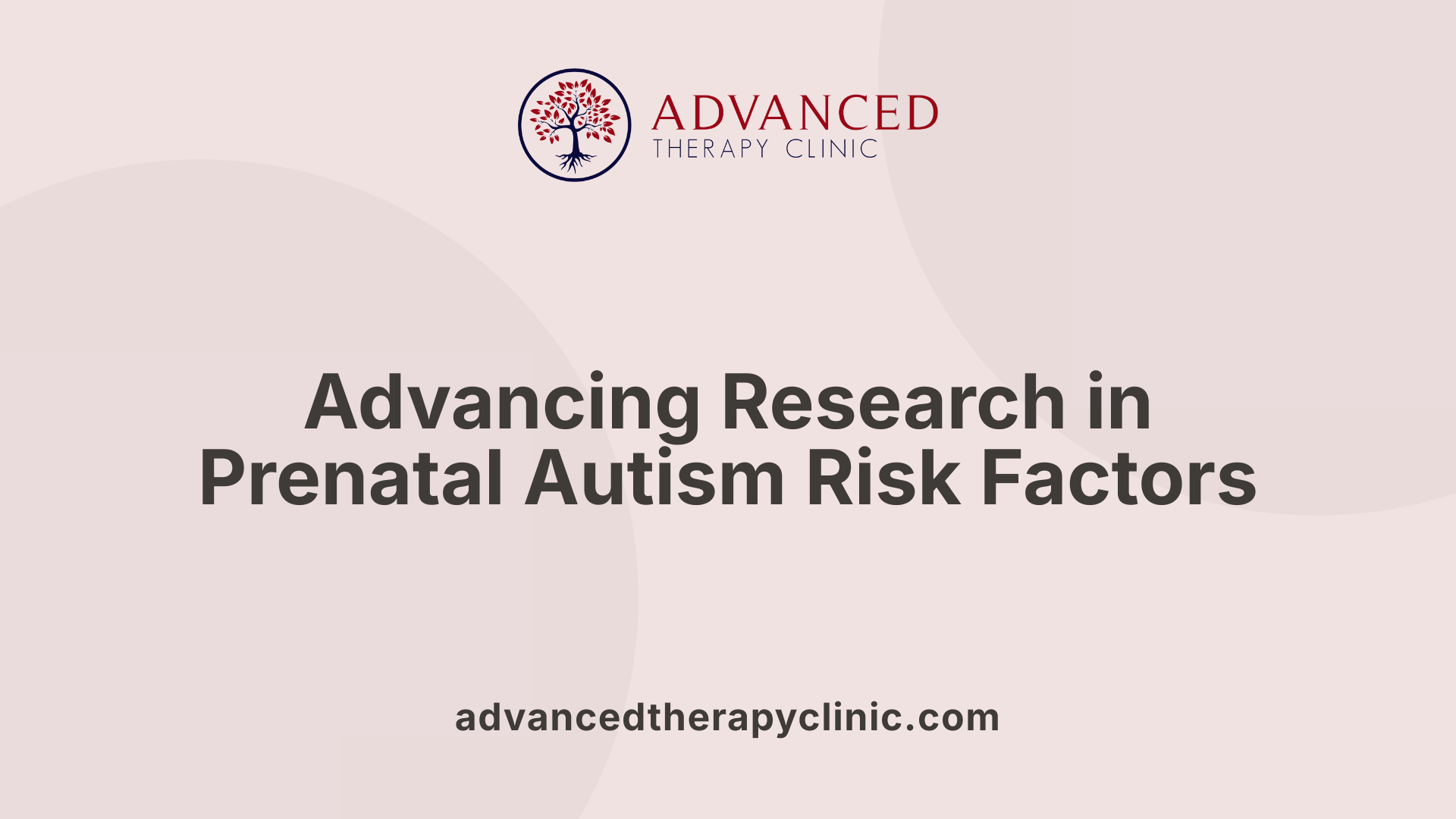Lead Exposure & Fevers During Pregnancy Lead to Autism


Understanding Prenatal Influences on Autism Risk and Severity
Emerging research has highlighted the complex interplay of prenatal environmental factors contributing to the development and severity of autism spectrum disorder (ASD). Among these, maternal health conditions and exposures during pregnancy have come under scrutiny for their potential role in shaping neurodevelopmental outcomes. This article delves into the critical influence of maternal fever and gestational diabetes during pregnancy, contextualizing their associations with ASD, and examines underlying biological mechanisms and related factors influencing the risk and severity of autism in children.
The Link Between Gestational Diabetes and Autism Severity

How does gestational diabetes affect autism spectrum disorder severity?
Maternal gestational diabetes (GDM) has been found to significantly impact the severity of autism spectrum disorder (ASD) in children. Research shows that children born to mothers with GDM are about 4.5 times more likely to experience severe forms of ASD compared to those whose mothers did not have the condition. This is reflected in an adjusted odds ratio (aOR) of 4.553, emphasizing a strong statistical association.
Gestational Diabetes and Maternal Health During Pregnancy
Gestational diabetes is a critical maternal health factor during pregnancy that not only affects the immediate well-being of the mother but also has long-term implications for the child's neurodevelopment. While other maternal factors such as recurrent infections, anemia, and environmental exposures have been observed, only gestational diabetes has demonstrated a clear, statistically significant correlation with more severe ASD outcomes.
Why Managing Maternal Health Matters
Maintaining maternal health during pregnancy is essential to potentially influence ASD severity positively. Proper management and treatment of gestational diabetes may help reduce the likelihood of severe autism manifestations in offspring. This insight underscores the importance of prenatal care focused on monitoring and controlling maternal metabolic conditions.
This evidence highlights the need for increased awareness and healthcare strategies targeting gestational diabetes, aiming to improve neurodevelopmental outcomes, including the severity of ASD, in children.
Oxygen Desaturation at Birth as a Risk Factor for Severe ASD
What is the impact of oxygen desaturation at birth on autism severity?
Children experiencing oxygen desaturation at birth face a significantly increased risk of developing severe autism spectrum disorder (ASD). Studies have found that these children have about a 4.1 times higher likelihood of more severe ASD compared to their counterparts without oxygen desaturation, as indicated by an adjusted odds ratio (aOR) of 4.142.
Oxygen desaturation refers to a condition in which the newborn's blood oxygen levels fall below normal soon after birth. This situation can affect brain oxygen supply during a critical period of neonatal development and may predispose the child to neurodevelopmental challenges.
The severity of ASD can vary widely, but factors like oxygen deprivation immediately after birth have been linked to worse outcomes. This highlights the importance of closely monitoring newborn health, particularly oxygen levels, to potentially mitigate risks related to ASD progression.
While oxygen desaturation is one significant factor, it is often interrelated with other prenatal and perinatal factors. Comprehensive newborn care and early intervention remain crucial to improving long-term outcomes for children at risk for neurodevelopmental disorders.
The Role of Child's Age in ASD Severity Progression
Does the child’s age influence the severity of autism?
Yes. Research shows that a child’s age significantly influences the severity of autism spectrum disorder (ASD). Specifically, with each additional year of age, the odds of experiencing more severe ASD increase by approximately 7.1%. This suggests that ASD severity is not static and may progress or become more noticeable as children grow older.
Developmental trajectory of ASD
ASD is a complex neurodevelopmental condition whose symptoms can evolve over time. The increasing severity with age might reflect various factors, such as the growing social and communication demands placed on the child, or how early interventions and support systems impact their developmental course. Understanding this progression highlights the importance of continuous monitoring and adaptable care strategies throughout childhood.
This age-related increase in ASD severity underscores the need for long-term follow-up and tailored interventions that can accommodate changing needs as children develop. Early diagnosis and ongoing support remain critical to managing the disorder and improving outcomes for affected individuals.
Fever During Pregnancy and Increased Risk of Neurodevelopmental Disorders
How common is fever during pregnancy?
Fever affects roughly 20% of pregnant women at some stage during their pregnancy. This relatively frequent occurrence highlights the importance of understanding its potential effects on fetal development.
How does fever during pregnancy affect the risk of neurodevelopmental disorders?
Exposure to maternal fever during pregnancy increases the risk of neurodevelopmental disorders (NDD) in children by about 24%. Specific conditions linked to maternal fever include autism spectrum disorder (ASD) and developmental delay (DD), with odds ratios of 1.15 and 1.23, respectively. The risk is notably higher when fever occurs during the first trimester, where the odds of NDD increase by approximately 13%.
Why does fever during the first trimester carry heightened risk?
The first trimester is a critical period for fetal brain development, involving key processes such as neuronal proliferation and migration. Fever during this window is thought to activate the maternal immune system, triggering the release of cytokines like interleukin-6 (IL-6). These immune responses can disrupt normal brain development, potentially leading to neurodevelopmental issues.
Do fever duration or medications during pregnancy influence this risk?
Current evidence shows no significant difference in NDD risk based on whether fever lasts longer than three days or whether antipyretic medications, such as acetaminophen, are used. Numerous studies confirm that acetaminophen use during pregnancy does not increase the risk of ASD.
Understanding the relationship between maternal fever and neurodevelopmental outcomes underscores the importance of maternal health monitoring, particularly in early pregnancy. Managing infections and monitoring immune responses may be crucial steps to reduce risks associated with fever during this sensitive developmental period.
First Trimester Fever: A Critical Window for ASD Risk

Why is fever during the first trimester especially significant for ASD risk?
Fever during the first trimester of pregnancy stands out as a particularly important risk factor for neurodevelopmental disorders (NDD), including autism spectrum disorder (ASD). Research shows that maternal fever in this early stage is associated with a 13% increased risk of NDD overall, with a 15% higher likelihood specifically for ASD compared to pregnancies without fever.
This heightened risk seems to be linked to the timing of fetal brain development. The first trimester is a critical period marked by intense neuronal proliferation and migration. Any disruptions during this window can have profound consequences on neural circuit formation and function, potentially leading to developmental challenges later in life.
The biological mechanism thought to underlie this association is maternal immune activation driven by fever. Cytokines such as interleukin-6 (IL-6) released during this immune response can cross the placenta and influence fetal brain development, possibly altering neurodevelopment trajectories. Animal studies support this, demonstrating that maternal immune activation can induce behavioral abnormalities in offspring that resemble human NDD.
Importantly, studies have clarified that prolonged fever duration or use of antipyretic medications during pregnancy do not significantly alter the risk, highlighting the timing rather than fever severity or treatment as the critical factor. Additionally, fever occurring in the second and third trimesters is not linked to increased NDD risk, underscoring the unique vulnerability of the first trimester.
Understanding this critical window emphasizes the importance of reducing infections and managing maternal health early in pregnancy to potentially mitigate ASD risks.
| Factor | Odds Ratio (OR) | Significance |
|---|---|---|
| Fever during entire pregnancy | 1.24 | 24% higher NDD risk |
| Fever during first trimester | 1.13 | 13% higher NDD risk |
| ASD risk associated with fever | 1.15 | 15% increased odds |
| Fever in 2nd/3rd trimester | Not significant | No increased NDD risk detected |
This evidence underscores the critical nature of the first trimester as a sensitive period for fetal brain development where maternal fever can elevate ASD risk.
Biological Mechanisms: Maternal Immune Activation and Cytokines
What biological mechanisms explain the link between maternal fever and ASD?
Maternal fever during pregnancy triggers the immune system to activate, resulting in the release of inflammatory molecules called cytokines. One cytokine in particular, interleukin-6 (IL-6), plays a significant role in this process. Elevated IL-6 levels can interfere with the delicate stages of fetal brain development, especially during the first trimester when neuronal proliferation and migration are most critical.
This maternal immune activation (MIA) can create an environment that disrupts normal neural growth and connectivity. Animal studies provide strong evidence supporting this mechanism, demonstrating that activation of the maternal immune system during pregnancy leads to offspring exhibiting behavioral abnormalities similar to human neurodevelopmental disorders, including autism spectrum disorder (ASD).
In summary, the biological link between maternal fever and increased ASD risk is rooted in the immune response. The cascade initiated by fever-induced inflammation, notably through IL-6, influences fetal brain development in ways that increase vulnerability to neurodevelopmental issues. Understanding this pathway highlights the importance of managing maternal health and immune system challenges during pregnancy to aid in reducing ASD risk.
Assessing the Impact of Fever Duration and Antipyretic Use During Pregnancy

Does the duration of maternal fever or use of antipyretics affect the risk of ASD?
Studies show that while maternal fever during pregnancy is linked to an increased risk of neurodevelopmental disorders such as autism spectrum disorder (ASD), neither the length of the fever nor the use of antipyretic medications significantly alters this risk.
Research indicates that a fever lasting longer than three days does not increase the likelihood of ASD or other neurodevelopmental disorders beyond the risk posed by the fever itself. Similarly, taking antipyretics during pregnancy to reduce fever does not appear to change the risk for these disorders.
This suggests that it is the occurrence of fever and the associated maternal immune activation that primarily influences the risk, rather than how long the fever lasts or the fever management strategies employed. Cytokines released during fever, particularly interleukin-6 (IL-6), may affect fetal brain development during critical windows, especially in the first trimester.
Therefore, while it remains important for expecting mothers to manage fever and maintain overall health, concerns about prolonged fever duration or antipyretic medication use should not overshadow the significance of fever itself as a risk factor for neurodevelopmental outcomes.
| Aspect | Effect on NDD Risk | Notes |
|---|---|---|
| Fever duration (>3 days) | No significant increase | Duration does not modify risk beyond fever presence |
| Antipyretic medication | No significant effect | Medications like acetaminophen do not increase ASD risk |
| Presence of fever | Increases risk of ASD and developmental delay | Particularly critical during the first trimester |
Comparing Other Maternal Factors: Infections, Anemia, and Air Pollution
Are other maternal conditions like infections, anemia, and air pollution linked to ASD severity?
During pregnancy, various maternal health factors such as recurrent infections, anemia, and exposure to air pollution have been examined for their potential influence on autism spectrum disorder (ASD) severity in children. These conditions are recognized for their general impact on fetal development, but when specifically assessing their association with ASD severity, the evidence highlights some distinctions.
Recurrent infections during pregnancy are relatively common and can activate maternal immune responses. While this activation can affect fetal neurodevelopment, current data indicate that infections alone do not have a statistically significant link to increasing ASD severity compared to other factors.
Anemia during pregnancy is another concern, as it may reduce oxygen delivery to the fetus and contribute to developmental challenges. Despite these risks, studies have not found a clear, significant correlation between maternal anemia and the worsening severity of ASD symptoms.
Exposure to air pollution has been proposed as an environmental risk factor affecting brain development. Although prolonged or high-level exposure could negatively impact fetal outcomes, this also has not shown a statistically significant association with heightened ASD severity in children.
Among these maternal health and environmental conditions, gestational diabetes mellitus (GDM) stands out as the one with a clear and significant association, presenting an adjusted odds ratio (aOR) of 4.553 for increased ASD severity. This suggests that while managing conditions like infections, anemia, and pollution exposure remains important for overall pregnancy health, addressing gestational diabetes could be particularly impactful in influencing ASD outcomes.
In summary, despite the presence of multiple maternal factors during pregnancy that could plausibly affect neurodevelopment, only gestational diabetes has demonstrated a statistically meaningful correlation with the severity of ASD according to current research findings.
Parental Lifestyle and Environmental Exposures During Pregnancy
How do parental lifestyle factors during pregnancy relate to neurodevelopment outcomes?
Both paternal and maternal lifestyle choices during pregnancy can influence the neurodevelopment of their children, but the evidence varies in strength. Key factors recorded include exposure to soft drinks, smoking habits, and maternal medication intake.
Paternal and maternal consumption of soft drinks and smoking were monitored for potential effects on the child's neurodevelopment. Although these factors are linked in some studies to adverse outcomes, not all have demonstrated a statistically significant association with autism spectrum disorder (ASD) or other neurodevelopmental disorders (NDD). This suggests that while lifestyle exposures might contribute, they may not be independent or strong predictors on their own.
Similarly, maternal intake of medications during pregnancy was tracked due to concerns about potential risks to fetal brain development. However, authoritative research, including recent large-scale studies, indicates no conclusive evidence linking maternal use of common medications such as acetaminophen to ASD.
The complexity of these relationships is underscored by confounding factors. For example, underlying conditions prompting medication use, like fever or infection, may themselves be risk factors for neurodevelopmental challenges, rather than the medications alone.
Overall, while parental lifestyle factors and maternal medication use are important considerations, current research points to only some exposures bearing significant neurodevelopmental risk. Managing maternal health holistically, including minimizing harmful exposures and addressing prenatal conditions, remains critical to supporting optimal outcomes for children.
The Influence of Maternal Age on Neurodevelopmental Disorder Risk
Does maternal age impact the risk of neurodevelopmental disorders like ASD?
Yes. Research has shown that maternal age is an important factor influencing the risk of neurodevelopmental disorders (NDD) such as autism spectrum disorder (ASD) in children. Meta-regression studies specifically highlight that mothers over the age of 35 have a significantly higher likelihood of bearing offspring with NDD.
This increased risk may be associated with various biological changes linked to advanced maternal age, including genetic and epigenetic factors that affect fetal development. It is important to consider maternal age as part of the broader context of prenatal risk factors influencing child neurodevelopment.
Given the rising trend of delayed childbearing globally, awareness of this association serves to guide clinical counseling and prenatal care strategies aimed at mitigating NDD risks. Mothers in this age group may benefit from enhanced monitoring and targeted interventions during pregnancy to support optimal neurodevelopmental outcomes.
Understanding maternal age alongside other prenatal and environmental risks can improve preventive approaches against disorders like ASD, helping healthcare providers offer tailored advice and support to expecting mothers.
Clarifying the Role of Acetaminophen Use During Pregnancy
Is there evidence supporting acetaminophen use during pregnancy as a cause of autism?
Concerns have been raised about whether acetaminophen taken during pregnancy might increase the risk of autism spectrum disorder (ASD) in children. However, thorough investigations by multiple authoritative organizations, such as the American College of Obstetricians and Gynecologists and the Society for Maternal-Fetal Medicine, have found no evidence supporting a causative link between acetaminophen use during pregnancy and ASD.
Recent large-scale studies further reinforce this finding. For example, studies conducted in Sweden and Japan, including one published in the Journal of the American Medical Association, indicate no association between maternal acetaminophen use and autism risk. These studies accounted for various confounding factors and carefully distinguished the effects of acetaminophen from the underlying conditions prompting its use.
Earlier studies that suggested a potential connection may have been influenced by confounding factors, such as fever or infection. These conditions themselves are known risk factors for neurodevelopmental disorders, including ASD. This implies that it is the underlying illness, rather than acetaminophen, that may contribute to increased autism risk.
From a clinical and safety perspective, acetaminophen remains a commonly recommended medication for managing pain and fever during pregnancy. The current evidence supports its safe use without increasing the risk of ASD in offspring, a critical reassurance for expectant mothers needing effective symptom relief during pregnancy.
Understanding the Broader Spectrum of Prenatal Influences on ASD
What are the wide-ranging prenatal and lifestyle factors influencing ASD?
Autism Spectrum Disorder (ASD) is influenced by an interplay of multiple prenatal, natal, environmental, psychosocial, and lifestyle factors. Among maternal health conditions during pregnancy, gestational diabetes stands out with a particularly strong association with increased severity of ASD, elevating the risk by roughly 4.5 times.
Other prenatal complications such as recurrent infections, anemia, and exposure to air pollution are also frequently documented but do not show the same statistically significant link to ASD severity as gestational diabetes. Similarly, paternal and maternal exposure to soft drinks, smoking, and maternal medication use during pregnancy have been researched, with some potential but mostly inconclusive implications for neurodevelopment.
This complexity underscores the multifactorial nature of ASD risk. Notably, factors experienced during birth, such as oxygen desaturation, also contribute to a markedly higher likelihood of severe ASD cases.
Environmental exposures such as maternal fever during pregnancy significantly increase the risk of neurodevelopmental disorders including ASD and developmental delays. Fever in the first trimester, for example, correlates with a 13% increased risk of neurodevelopmental complications, highlighting the critical timing of such exposures on fetal brain development.
Psychosocial elements and maternal stress are also pointed out as important, reinforcing the notion that comprehensive maternal care and stress management during pregnancy play crucial roles in potentially influencing ASD outcomes in children.
Understanding the spectrum of these factors invites a holistic approach to prenatal care, emphasizing the management of maternal metabolic health, infection prevention, environmental exposures, and stress reduction to support optimal neurodevelopmental trajectories.
The Significance of Neurodevelopmental Disorder Research Scale
How robust is the evidence linking maternal fever and neurodevelopmental disorders?
Recent research has delivered compelling evidence supporting the association between maternal fever during pregnancy and an increased risk of neurodevelopmental disorders (NDD) such as autism spectrum disorder (ASD) and developmental delay (DD). This connection is underpinned by systematic reviews and meta-analyses that include data from more than 10,000 children diagnosed with NDD and over 80,000 mothers who experienced fever during pregnancy.
These large-scale studies provide a strong foundation, revealing that fever during pregnancy raises the risk of neurodevelopmental disorders by approximately 24% (OR 1.24, 95% CI: 1.12–1.38). The first trimester specifically emerges as a critical period, with fever increasing NDD risk by 13% (OR 1.13, 95% CI: 1.02–1.26). Further analysis pinpoints specific disorders such as ASD (OR 1.15, 95% CI: 1.01–1.31) and DD (OR 1.23, 95% CI: 1.07–1.41) as being particularly associated with maternal fever.
Systematic Reviews and Large-Scale Studies
Systematic reviews synthesize findings from multiple studies, enhancing reliability and minimizing bias. The amalgamation of data from tens of thousands of cases ensures that conclusions draw from diverse populations and various research designs, increasing confidence in the association’s validity.
In addition, high-powered meta-analyses leverage this wealth of data to quantify risk more precisely. They have confirmed the unique vulnerability of the first trimester, aligning with critical stages of neuronal development like proliferation and migration.
Strength of Evidence
The strength of this evidence derives not only from the size of the studied population but also from the consistency of findings across studies and the biological plausibility offered by underlying mechanisms. For example, maternal immune activation with cytokine release, especially interleukin-6 (IL-6), provides a credible pathophysiological explanation connecting fever to altered fetal brain development.
Moreover, the research distinguishes fever effects from confounding factors such as medication use during pregnancy. For instance, analyses show no causal link between acetaminophen use in pregnancy and ASD, underscoring the importance of isolating specific risk contributors.
Overall, the robust nature of the evidence base underscores maternal fever during pregnancy as a noteworthy factor in neurodevelopmental disorder risk, emphasizing the need for preventive care and management strategies during this vulnerable period.
Critical Periods in Fetal Brain Development Related to ASD
Why is the first trimester particularly vulnerable for neurodevelopmental disorders?
The first trimester of pregnancy represents a crucial stage in fetal brain development, primarily because it encompasses the periods of neuronal proliferation and migration. During this time, neurons are rapidly generated and begin moving to their destined locations in the developing brain. This process lays the foundational structure necessary for proper brain function.
Environmental exposures during this critical window, such as maternal fever and immune activation, can significantly disrupt neuronal growth and placement. For example, maternal fever prompts immune responses that increase cytokine levels, particularly interleukin-6 (IL-6), which are believed to interfere with standard brain development. The disruption caused by such immune activations aligns with increased risks of neurodevelopmental disorders (NDD), notably autism spectrum disorder (ASD).
The heightened vulnerability of the fetal brain during the first trimester corresponds to these essential developmental milestones. Disturbances in this period have more pronounced consequences than exposures occurring in later trimesters when many neural circuits have already formed and matured. This explains why maternal fever during the first trimester shows a stronger association with ASD risk (OR 1.15) compared to fever in subsequent trimesters.
Understanding this timing helps clarify why certain prenatal factors, including maternal health and infections, can drastically influence the severity and occurrence of neurodevelopmental disorders. Managing maternal conditions during early pregnancy is thus imperative to reducing risks linked to fetal brain disruption and subsequent ASD severity.
Maternal Immune Activation and Autism: Insights from Animal Models
What do animal studies reveal about maternal immune activation and autism?
Animal studies have been instrumental in understanding how maternal immune activation (MIA) during pregnancy impacts fetal brain development. These studies simulate infections or immune challenges in pregnant animals to observe subsequent effects on offspring. The findings consistently show that such immune activation disrupts normal neurodevelopment, leading to behavioral abnormalities that closely mirror those observed in human neurodevelopmental disorders (NDD), including autism spectrum disorder (ASD).
Maternal Immune Activation Mechanisms
Research indicates that maternal immune activation triggers the release of pro-inflammatory cytokines, particularly interleukin-6 (IL-6), which can cross the placental barrier and influence fetal brain development. Elevated IL-6 levels are linked to altered neuronal proliferation, migration, and synapse formation during critical developmental windows, which may predispose offspring to ASD-like behavioral patterns.
Behavioral Abnormalities Observed in Animal Models
Offspring of animals subjected to MIA exhibit a range of behavioral deficits such as impaired social interactions, repetitive behaviors, and increased anxiety—core features commonly associated with ASD in humans. These behavioral phenotypes reinforce the role of immune-mediated mechanisms as a potential contributor to autism pathogenesis.
Collectively, animal models provide strong biological evidence supporting the hypothesis that maternal immune responses to infection or inflammation during pregnancy can alter fetal neurodevelopment and increase the risk of autism spectrum disorder. This scientific foundation underscores the importance of managing maternal health and immune challenges during pregnancy to potentially mitigate such risks.
Patterns of Fever Exposure Through Pregnancy Trimesters
How does fever during different pregnancy trimesters affect neurodevelopmental disorder risk?
Fever during pregnancy has been shown to increase the risk of neurodevelopmental disorders (NDD) in offspring, but the impact varies depending on the timing within pregnancy. The first trimester is particularly critical, as fever in this period corresponds with a 13% increased risk of NDD (OR 1.13, 95% CI 1.02–1.26). This elevated risk aligns with the stage of fetal brain development when neuronal proliferation and migration are most active, making the brain more vulnerable to insults.
In contrast, fever occurring in the second and third trimesters does not significantly increase the risk of NDD. Studies indicate no statistically meaningful association of fever later in pregnancy with disorders such as autism spectrum disorder (ASD) or developmental delay (DD). This suggests that fetal brain sensitivity to maternal immune activation is heightened early in gestation.
The specific disorders linked to first-trimester fever include ASD, with an odds ratio of 1.15 (95% CI 1.01–1.31), and DD, with an OR of 1.23 (95% CI 1.07–1.41). This pattern is supported by meta-analyses reviewing large cohorts, reinforcing the idea that the timing of fever exposure plays a crucial role in determining neurodevelopmental outcomes.
Overall, these findings underscore the importance of monitoring maternal health and managing fever especially during the early stages of pregnancy to potentially mitigate risks to fetal brain development.
Potential Public Health Strategies to Manage Prenatal Risks for ASD

What strategies could help reduce ASD risk related to maternal exposures?
Public health efforts to lessen autism spectrum disorder (ASD) risk linked to maternal exposures should prioritize comprehensive maternal health management. A critical focus is on effective monitoring and treatment of gestational diabetes (GDM), which is significantly associated with a roughly 4.5-fold increased risk of severe ASD in children. Early screening and diabetes control during pregnancy can thus play a major role in risk mitigation.
Infection prevention is another pivotal area. Fever during pregnancy, particularly in the first trimester, raises the risk of neurodevelopmental disorders (NDD) including ASD by approximately 15%. Public health initiatives encouraging vaccination, hygiene practices, and timely medical care for infections can reduce fever occurrences and subsequent fetal brain immune activation.
Stress reduction strategies for pregnant women are equally important. Since maternal stress and environmental exposures such as air pollution may influence neurodevelopment, programs supporting mental well-being and minimizing harmful environmental contact can contribute positively.
Risk education plays a fundamental role. Informing expectant mothers about the impacts of factors like gestational diabetes, fever, and lifestyle choices—including consumption of soft drinks and smoking—allows for informed decision-making. Emphasizing that acetaminophen use is not linked causatively to ASD can also alleviate undue anxiety.
Together, these strategies offer a multi-pronged approach to potentially reduce the severity and frequency of ASD by improving prenatal care and maternal health awareness.
Distinguishing Correlation from Causation in Maternal Medication Use
How do researchers distinguish the effects of maternal medication from the underlying conditions?
Understanding whether maternal medication or the underlying condition itself influences neurodevelopment requires careful study design and analysis. Early research suggesting a link between acetaminophen use during pregnancy and autism spectrum disorder (ASD) was complicated by confounding factors—specifically, the illnesses that prompt medication use, such as fever or infections.
Fever and infections during pregnancy are independently associated with increased risks of neurodevelopmental disorders (NDD). For example, maternal fever, especially in the first trimester, raises the odds of ASD and developmental delay due to maternal immune activation and cytokine release, notably interleukin-6. This biological underpinning highlights that the illness, not necessarily the medication, could be the risk driver.
Robust research methodologies address these confounders by accounting for the timing, severity, and reasons for medication use alongside the maternal health status. Large-scale, peer-reviewed studies from Sweden and Japan have failed to find a causative link between acetaminophen use and ASD, suggesting prior associations likely reflected the impact of underlying illness rather than medication.
In summary, distinguishing the medication's effect from the illness involves comprehensive control of confounding variables and understanding biological mechanisms. Researchers rely on systematic reviews, meta-analyses, and carefully adjusted observational studies to establish clearer causal relationships in this complex field.
Broader Implications of Prenatal Environment Research for Therapy Fields
How does understanding prenatal risk factors inform therapy-related fields?
Understanding the prenatal environment’s impact on neurodevelopmental disorders, including autism spectrum disorder (ASD), provides critical insights for therapy professionals. Research shows that conditions like maternal gestational diabetes significantly increase the severity of ASD in children, as do prenatal oxygen desaturation events and maternal infections such as fever during pregnancy.
Therapists specializing in applied behavior analysis (ABA), physical, occupational, and speech therapy can leverage this knowledge to better tailor early interventions. Awareness that a child’s ASD severity may be linked to specific prenatal risk factors allows clinicians to anticipate developmental challenges and customize treatment plans accordingly. For example, a child born to a mother with gestational diabetes or who experienced oxygen desaturation at birth might require more intensive or nuanced developmental support.
Additionally, counselors and nutritionists working with families can integrate this information into prenatal care education and early childhood support. Emphasizing maternal health management—such as controlling diabetes during pregnancy and minimizing infection risks—can potentially improve neurodevelopmental outcomes. These insights also underscore the importance of prenatal risk awareness campaigns, informing healthcare providers and families about factors that may contribute to ASD severity.
Ultimately, integrating prenatal environmental risk awareness into therapy fields enhances the precision and effectiveness of early interventions. It empowers therapists to consider not just postnatal symptoms but also underlying prenatal influences, guiding more comprehensive and informed therapeutic strategies that support better long-term outcomes for children with ASD.
Challenges and Future Research Directions in Autism Prenatal Risk Analysis

What are the main challenges and future directions in studying prenatal autism risks?
Understanding prenatal risk factors for autism spectrum disorder (ASD) is complex due to the multifactorial nature of the condition. Various maternal health issues like gestational diabetes and fever during pregnancy have been linked to increased ASD severity and risk. However, isolating each factor's unique contribution is challenging because these risks often coexist and interact with environmental, psychosocial, and lifestyle influences.
One major challenge is controlling for confounders in research studies. For example, early findings linking acetaminophen use to ASD have been reconsidered as likely confounded by the underlying causes for its use, such as fever or infection, both of which themselves elevate neurodevelopmental disorder risks. Disentangling these intertwined variables requires rigorous study designs.
Data limitations also arise, including reliance on retrospective reporting and a lack of detailed exposure timing. Identifying critical windows of vulnerability, such as the first trimester where fever-related ASD risks are notably increased, demands prospective and precisely timed assessments.
Longitudinal studies tracking children over time are essential to clarify how prenatal exposures translate into neurodevelopmental outcomes, including severity differences in ASD. These studies can help distinguish transient effects from lasting impacts.
Future research directions involve refining risk identification with larger, well-characterized cohorts and advanced statistical methods. There is also a need to elucidate underlying biological mechanisms, such as maternal immune activation mediated by cytokines like interleukin-6, that influence fetal brain development.
Ultimately, a better understanding will enable development of targeted prevention strategies and interventions to optimize maternal health during pregnancy, thereby potentially improving neurodevelopmental outcomes for offspring.
Integrating Knowledge on Maternal Factors to Mitigate Autism Risk
The mounting evidence linking maternal gestational diabetes and fever—especially during the early stages of pregnancy—to increased autism severity underscores the intricate relationship between prenatal environment and neurodevelopment. Biological insights into maternal immune activation clarify key mechanisms whereby fetal brain development may be disrupted. While other maternal factors and medication usages display more nuanced or non-significant associations, the importance of vigilant management of maternal health and environmental exposures remains paramount. Advancing research and effective public health strategies can equip healthcare providers, therapists, and families with tools to better anticipate, intervene, and support children at risk for autism spectrum disorder, fostering improved developmental trajectories and quality of life.
References
Recent articles

Expressive Speech Delay 2-Year-Old
Understanding and Addressing Expressive Speech Delay in Toddlers

How Speech Recognition Works
Unlocking the Power of Speech Recognition in Therapy and Healthcare

Autism and Head Size
Understanding the Complex Relationship Between Autism and Head Size

Occupational Therapy in Autism
Enhancing Independence and Quality of Life Through Occupational Therapy in Autism

Do Autistic People Understand Sarcasm?
Navigating the Nuances: Understanding Sarcasm and Social Communication in Autism

Autism Routines
Crafting Effective Daily Structures for Children with Autism


